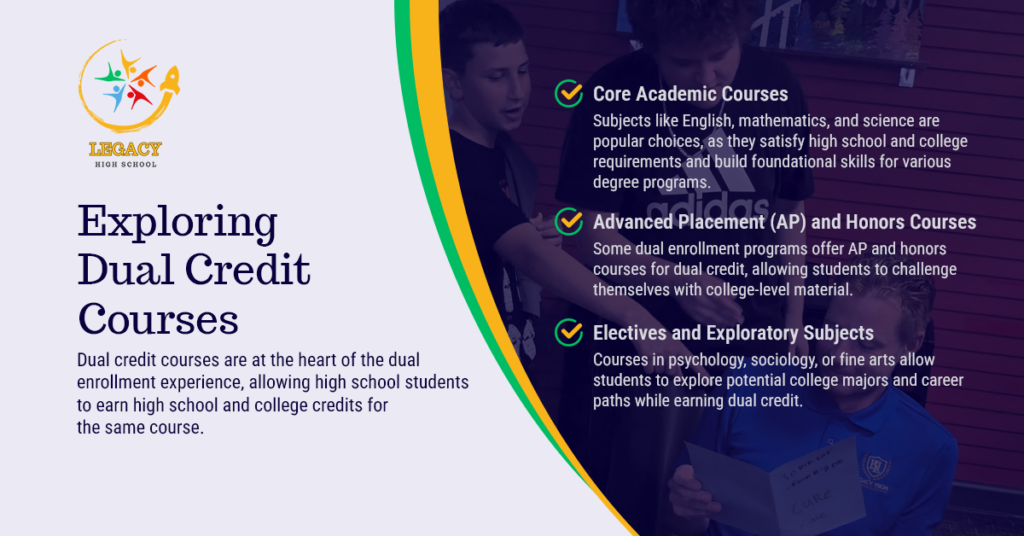Dual enrollment offers students an exciting opportunity to earn college credits while still in high school, setting them on a strong path toward academic success. At Legacy High School, we believe in empowering each student to explore their potential, and dual enrollment allows for just that by blending high school and college-level learning.
With the chance to dive deeper into their passions and develop a more profound love for learning, students who participate in dual enrollment can graduate high school already ahead on their college journey. Dual enrollment is more than just an academic choice; it’s a way for students to create their legacy.
Understanding Dual Enrollment Requirements
Dual enrollment is an incredible opportunity for high school students to gain college experience and credits, but understanding dual enrollment requirements is vital to making the most of this option. Legacy High School is committed to supporting students in navigating these requirements, ensuring a smooth transition into college-level academics.
Overview of Eligibility Criteria
To take part in dual enrollment, students must meet specific academic and personal criteria that reflect their readiness for college coursework. At Legacy High School, we work closely with students and families to ensure they meet these standards, which often include:
- A minimum GPA: Many colleges require a certain grade point average, typically around 2.5 to 3.0, to ensure students are academically prepared.
- Recommendations or permissions: Schools often require recommendations from teachers or guidance counselors to confirm a student’s readiness.
- Age and grade level requirements: Most programs are open to juniors and seniors, though some colleges may have opportunities for younger students.
Each college’s dual enrollment requirements may differ, so Legacy provides tailored guidance to help students choose the right program and meet all prerequisites.
Steps to Meet Academic and Administrative Requirements
Once students understand the eligibility criteria, they must complete the application process, including meeting academic and administrative requirements. Legacy High School walks students through each step, helping them stay organized and confident.
Here are some typical steps students can expect:
- Review eligibility requirements and select potential courses: Students first identify courses or fields of interest that match their academic path.
- Complete application forms: Colleges often require an application, transcripts, and relevant test scores.
- Submit recommendations or permissions: Students may need teacher or counselor endorsements confirming their readiness for college-level work.
- Attend orientation or information sessions: Some dual enrollment programs offer orientations to help students understand expectations and resources available to them.
By following these steps and preparing thoroughly, students can confidently meet dual enrollment requirements, ready to take on the challenges of college coursework while still in high school. Dual enrollment is not only about meeting requirements; it’s about creating a pathway to a thriving academic journey and, ultimately, a lasting legacy.
Exploring Dual Credit Courses

Dual credit courses are at the heart of the dual enrollment experience, allowing high school students to earn high school and college credits for the same course. These courses are invaluable for preparing students for college-level learning and fostering academic growth. Exploring the array of dual credit courses helps students make choices that align with their goals and interests.
Types of Courses Available for Dual Credit
Dual credit courses typically cover a broad spectrum of subjects, from core academics to specialized electives. These courses provide high school students with an authentic college experience while ensuring they meet graduation requirements. Some common types of dual credit courses include:
- Core academic courses: Subjects like English, mathematics, and science are popular choices, as they satisfy high school and college requirements and build foundational skills for various degree programs.
- Advanced Placement (AP) and honors courses: Some dual enrollment programs offer AP and honors courses for dual credit, allowing students to challenge themselves with college-level material.
- Electives and exploratory subjects: Courses in psychology, sociology, or fine arts allow students to explore potential college majors and career paths while earning dual credit.
With guidance from academic advisors, students can identify dual credit courses that best match their strengths and career aspirations, encouraging them to explore their interests while earning valuable college credits.
How Dual Credit Courses Align with High School and College Curricula
One key benefit of dual credit courses is their alignment with high school and college curricula. These courses are carefully structured to ensure that students meet high school requirements while gaining the college credits they need to advance their academic journeys.
Students can choose courses that fit seamlessly into their high school curriculum so they’re not overwhelmed by the additional workload. This alignment allows students to progress toward high school graduation while building a solid college foundation. With clear guidance on how each course counts toward high school and college requirements, students benefit from a smooth, integrated learning experience.
Examples of Popular Subjects and Fields of Study
The wide range of subjects available through dual credit courses allows students to tailor their studies to their interests and future goals. Some of the most popular fields of study among dual enrollment students include:
- STEM (Science, Technology, Engineering, and Math): Courses in biology, chemistry, computer science, and calculus are popular for students aiming for careers in technology, engineering, or medicine.
- Humanities: Subjects like English literature, history, and philosophy appeal to students interested in developing critical thinking and communication techniques, which are highly valued across many fields.
- Social Sciences: Courses in psychology, sociology, and economics help students gain insights into human behavior and societal dynamics, ideal for those considering careers in counseling, business, or law.
- Fine Arts and Creative Subjects: Dual credit courses in music, art, or theater allow students with a creative spark to explore their passions while earning college credits.
By exploring dual credit courses, students get a head start on college and gain the confidence to pursue their interests and discover potential career paths. These courses provide a rich academic experience that challenges students and empowers them to embrace college-level learning.
Advantages of Dual Enrollment in Secondary Education

Dual enrollment offers students an exciting blend of high school and college education, bringing numerous advantages that enrich their secondary education experience and set them up for future success. By participating in dual enrollment, students advance academically and develop valuable life skills that prepare them to transition to college and beyond.
Enriching the High School Experience
Dual enrollment provides a particular opportunity for students to engage with challenging material, explore new subjects, and elevate their learning experience. This added depth brings several benefits:
- Increased academic challenge: College-level courses provide rigor and challenge, encouraging students to stretch their abilities, which keeps them motivated and engaged.
- Expanded subject options: Dual enrollment allows students to study topics beyond those available in high school, such as psychology, engineering, or advanced sciences, opening the door to different interests and potential career paths.
- Exposure to different learning environments: College courses often require students to adopt new study habits, adapt to diverse teaching styles, and practice independent learning skills.
Through these experiences, students gain a richer, more varied high school education that keeps them engaged while exploring their full potential.
Gaining Early Exposure to College-Level Academics
Dual enrollment serves as an excellent bridge to college, allowing students to experience college coursework while still enjoying the support of their high school community. This early exposure equips students with essential skills and insights for the transition to college, such as:
- Time management: Students learn to prioritize and balance their workload, improving their organizational skills as they face the demands of college-level assignments and exams.
- Independent study habits: College courses require more self-guided learning, encouraging students to develop initiative and responsibility in their academic pursuits.
- Adaptable study techniques: Exposure to different assessments and teaching methods helps students refine their study skills and approach learning more flexibly.
Dual enrollment eases the transition to college by familiarizing students with these academic expectations. It also gives them a head start on essential skills that will benefit them well throughout their educational journey.
Promoting Personal Growth and Self-Confidence
Alongside academic benefits, dual enrollment encourages personal growth, helping students build resilience, self-confidence, and self-discipline. As they navigate the responsibilities of college coursework, students develop:
- Greater self-confidence: Completing college-level assignments builds a sense of accomplishment and empowers students to tackle future challenges.
- Goal-setting and achievement: Balancing high school and college coursework teaches students the importance of setting and working diligently to achieve goals.
- Enhanced decision-making: As students make choices about their schedules, time management, and course selection, they become more adept at making informed decisions, which will be valuable throughout life.
Through these experiences, students build a foundation of self-reliance and independence, which will benefit them academically and personally.
Strengthening College Applications and Future Opportunities
One of the critical advantages of dual enrollment is the competitive edge it provides for college admissions and future job prospects. Having dual enrollment experience on their transcripts demonstrates a commitment to academic excellence and readiness for higher-level work, traits that colleges and employers find appealing. Additional benefits include:
- A standout academic record: Dual enrollment showcases students’ ability to succeed in challenging coursework, making them more attractive to college admissions committees.
- Early college credits: By earning college credits early, students can lighten their future course loads or graduate sooner, allowing for more flexibility to pursue internships, work, or extracurriculars.
- Career readiness: Dual enrollment prepares students for college and helps them develop a professional mindset and academic discipline, which are valuable skills in any career path.
Dual enrollment enriches the secondary education experience, fosters personal growth, and provides a foundation for future success. By taking on the challenge of college coursework while still in high school, students gain valuable skills, confidence, and a competitive edge that will serve them well in college and beyond.
Conclusion
Dual enrollment is a powerful opportunity that allows students to confidently step into their future, equipped with the skills and experiences that set them up for success. From the added academic rigor to the personal growth and college credits earned, dual enrollment empowers students to make the most of their high school years while building a strong foundation for college and beyond. It’s an enriching experience that enhances education and inspires students to embrace new challenges, discover their passions, and feel prepared for the journey ahead.
If you’re ready to explore how dual enrollment can benefit your high school experience and open doors to future opportunities, reach out today! Visit our contact page or give us a call at (321) 345-4232. We’re here to support you in creating a legacy of learning and success!

